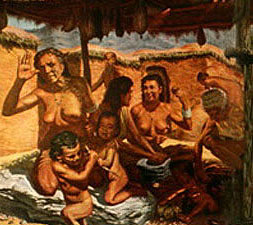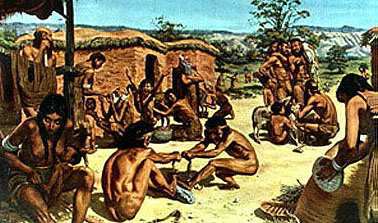Emergence of Agriculture
- page 7 -
Population Growth and Epidemic Diseases
 Another of the challenges of sedentary life is population growth. Mobile hunter-gatherer groups must necessarily limit the number of children they have to care for at any given time; their way of life simply does not permit large families or large child-to-adult ratios. Sedentary agriculturalists, however, do not face such natural constraints. On the contrary, large families of many children mean more hands to help in the fields. Thus, a tendency toward larger families is built into the new way of life. With the advent of agriculture as a way of life, human populations began to increase and then to soar in number. After 10,000 years of this way of life, the human population is still expanding exponentially. Today, there are between five and a half and six billion people on the planet, almost all of them supported by agriculture.
Another of the challenges of sedentary life is population growth. Mobile hunter-gatherer groups must necessarily limit the number of children they have to care for at any given time; their way of life simply does not permit large families or large child-to-adult ratios. Sedentary agriculturalists, however, do not face such natural constraints. On the contrary, large families of many children mean more hands to help in the fields. Thus, a tendency toward larger families is built into the new way of life. With the advent of agriculture as a way of life, human populations began to increase and then to soar in number. After 10,000 years of this way of life, the human population is still expanding exponentially. Today, there are between five and a half and six billion people on the planet, almost all of them supported by agriculture.
 A third challenge of a sedentary mode of life is infectious disease, a problem closely related to population growth and to the difficulty of maintaining a clean, healthy living space. Human beings can share many diseases with domestic animals; therefore the clustering of both humans and animals together in unsanitary villages created a perfect environment for pathogens of all kinds. As a result, early village life provided a breeding ground for new and deadly diseases. There is good evidence that in these conditions epidemics, previously very rare, became an all too common part of the human experience.
A third challenge of a sedentary mode of life is infectious disease, a problem closely related to population growth and to the difficulty of maintaining a clean, healthy living space. Human beings can share many diseases with domestic animals; therefore the clustering of both humans and animals together in unsanitary villages created a perfect environment for pathogens of all kinds. As a result, early village life provided a breeding ground for new and deadly diseases. There is good evidence that in these conditions epidemics, previously very rare, became an all too common part of the human experience.
Gradually, however, in response to these recurring epidemics of deadly infections, selected human populations of agriculturalists developed immunity to specific pathogens, so that many infectious diseases slowly lost their lethal effects. In our day, the common "childhood diseases" like mumps and measles and chicken pox are the relatively harmless descendants of once fatal diseases. This is evidence that the new way of life changed its human populations genetically.
 Another of the challenges of sedentary life is population growth. Mobile hunter-gatherer groups must necessarily limit the number of children they have to care for at any given time; their way of life simply does not permit large families or large child-to-adult ratios. Sedentary agriculturalists, however, do not face such natural constraints. On the contrary, large families of many children mean more hands to help in the fields. Thus, a tendency toward larger families is built into the new way of life. With the advent of agriculture as a way of life, human populations began to increase and then to soar in number. After 10,000 years of this way of life, the human population is still expanding exponentially. Today, there are between five and a half and six billion people on the planet, almost all of them supported by agriculture.
Another of the challenges of sedentary life is population growth. Mobile hunter-gatherer groups must necessarily limit the number of children they have to care for at any given time; their way of life simply does not permit large families or large child-to-adult ratios. Sedentary agriculturalists, however, do not face such natural constraints. On the contrary, large families of many children mean more hands to help in the fields. Thus, a tendency toward larger families is built into the new way of life. With the advent of agriculture as a way of life, human populations began to increase and then to soar in number. After 10,000 years of this way of life, the human population is still expanding exponentially. Today, there are between five and a half and six billion people on the planet, almost all of them supported by agriculture.